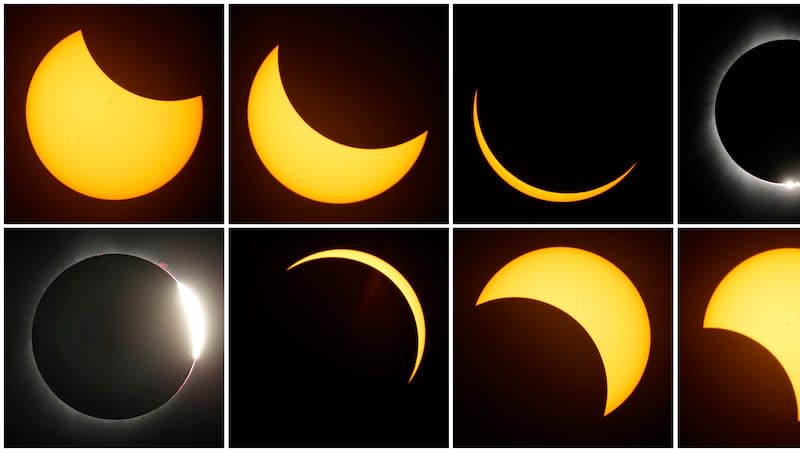Thunderstorm forecasts threaten to obscure views of the solar eclipse in path of totality

For those who live within the narrow path of totality, the upcoming total solar eclipse offers once-in-a-lifetime views. But storm warnings along the course threaten to obscure what could be a rare experience.
For the April 8 total solar eclipse, the part of the path of totality that’s in the U.S. begins in southwest Texas, then cuts through Oklahoma, Arkansas and eight more states before eventually finishing its American tour in Maine, per NASA.
Within the path, the moon completely blocks the sun — creating an effect of nighttime at midday. If the weather is clear, onlookers can see the form of a halo of light around the moon, according to NASA
Did you know that the total solar eclipse this April will last twice as long and will have a wider path than the eclipse in August 2017?
This eclipse will also look different since the Sun will be more active. Learn more about how this eclipse compares: https://t.co/3RJmAcAWzS pic.twitter.com/o2WHhhXBHC— NASA Sun & Space (@NASASun) February 2, 2024
Ahead of Monday’s big event, severe thunderstorms are brewing in the southern Plains and lower Mississippi Valley, carrying menacing clouds that could jeopardize total and partial views of the eclipse in the U.S., reports CNN. Thunderstorms, heavy rain, hail, high winds and even a possible tornado are on the radar for Monday, April 8, in Oklahoma, Arkansas and Louisiana.
As of Wednesday, cloudy weather is forecast in Austin-San Antonio and Dallas-Fort Worth — two regions in Texas that fall in the path of totality.
“The forecast for Eclipse Day continues to be partly to mostly cloudy. Widespread upper cloud cover is likely (>80% chance),” the National Weather Service office in Dallas-Fort Worth wrote on its website. “Dense low clouds near the Gulf Coast will move north during the day, obstructing the eclipse for parts of the region. How far north these clouds will advance is still uncertain.”
Northern regions near totality could also get their eclipse experience shadowed by clouds.
Based on historical averages, April is one of the cloudiest months of the year in the northeastern U.S., according to the National Weather Service. An average April day in the northeastern U.S. has between 60%-80% cloud coverage.
In northern Ohio, rainclouds threaten to roll in and block views of the eclipse. Meteorologist Scott Sabol told Cleveland’s Fox 8 he does not expect “super thick” cloud cover, but the chance of cloudy skies is climbing.
“More than a week ago we started tracking a front for Monday approaching from the west and southwest. Now that we’re five days out, the likelihood of mostly cloudy skies and a few light showers is beginning to rise,” Sabol told Fox 8.
According to the National Oceanic and Atmospheric Administration, average cloud cover for April 8 in areas of totality are as follows:
Dallas, Texas: 54% mostly cloudy or overcast, 46% clear to partly cloudy skies.
Little Rock, Arkansas: 51% mostly cloudy or overcast, 49% clear to partly cloudy skies.
Indianapolis, Indiana: 66% mostly cloudy or overcast, 34% clear to partly cloudy skies.
Buffalo, New York: 67% mostly cloudy or overcast, 33% clear to partly cloudy skies.
“You want to avoid any type of cloud, if you can,” Fred Espenak, a former astrophysicist from NASA Goddard Space Flight Center and author of “Road Atlas for the Total Solar Eclipse of 2024,” told ABC News of eclipse day.
“Let’s say it’s on a sunny day with some puffy cumulus clouds around. All you need is for one of those clouds to be in front of the sun and you’ve missed the total eclipse,” he continued, adding, “So, you’re really looking for a place with as few clouds as possible.”

